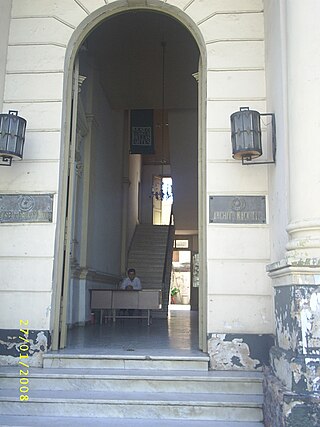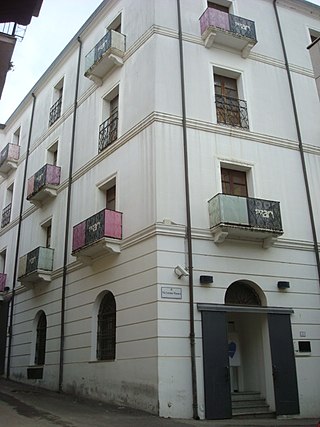
Grazia Maria Cosima Damiana Deledda was an Italian writer who received the Nobel Prize for Literature in 1926 "for her idealistically inspired writings which with plastic clarity picture the life on her native island [i.e. Sardinia] and with depth and sympathy deal with human problems in general". She was the first Italian woman to receive the prize, and only the second woman in general after Selma Lagerlöf was awarded hers in 1909.

CostantinoNivola was an Italian sculptor, architectural sculptor, muralist, designer, and teacher.

The Museo del Prado, officially known as Museo Nacional del Prado, is the main Spanish national art museum, located in central Madrid. It houses collections of European art, dating from the 12th century to the early 20th century, based on the former Spanish royal collection, and the single best collection of Spanish art. Founded as a museum of paintings and sculpture in 1819, it also contains important collections of other types of works. The numerous works by Francisco Goya, the single most extensively represented artist, as well as by Hieronymus Bosch, El Greco, Peter Paul Rubens, Titian, and Diego Velázquez, are some of the highlights of the collection. Velázquez and his keen eye and sensibility were also responsible for bringing much of the museum's fine collection of Italian masters to Spain, now one of the largest outside of Italy.

The Palacio de Bellas Artes is a prominent cultural center in Mexico City. This hosts performing arts events, literature events and plastic arts galleries and exhibitions. "Bellas Artes" for short, has been called the "art cathedral of Mexico", and is located on the western side of the historic center of Mexico City which is close to the Alameda Central park.

Jusepe de Ribera was a Spanish painter and printmaker. Ribera, Francisco de Zurbarán, Bartolomé Esteban Murillo, and the singular Diego Velázquez, are regarded as the major artists of Spanish Baroque painting. Referring to a series of Ribera exhibitions held in the late 20th century, Philippe de Montebello wrote "If Ribera's status as the undisputed protagonist of Neapolitan painting had ever been in doubt, it was no longer. Indeed, to many it seemed that Ribera emerged from these exhibitions as not simply the greatest Neapolitan artist of his age but one of the outstanding European masters of the seventeenth century." Jusepe de Ribera has also been referred to as José de Ribera, Josep de Ribera, and was called Lo Spagnoletto by his contemporaries and early historians.
Events from the year 1964 in art.

Su Nuraxi is a Nuragic archaeological site in Barumini, Sardinia, Italy. Su Nuraxi simply means "The Nuraghe" in Campidanese, the southern variant of the Sardinian language.

Chianciano Terme is a comune (municipality) in the Province of Siena in the Italian region Tuscany, located about 90 kilometres (56 mi) southeast of Florence and about 50 kilometres (31 mi) southeast of Siena. It is located between the Valdichiana and the Val d'Orcia.

Orani is a comune (municipality) in the Province of Nuoro in the Italian region Sardinia, located about 110 kilometres (68 mi) north of Cagliari and about 15 kilometres (9 mi) southwest of Nuoro. As of 31 December 2004, Orani had a population of 3,113 and an area of 130.8 square kilometres (50.5 sq mi).

Arbus is a comune (municipality) in the Province of South Sardinia in the Italian region of Sardinia.

The National Museum of Fine Arts of Asunción, located on Mcal. Estigarribia and Iturbe St. in Asuncion, the capital city of Paraguay, displays over 650 works of art, paintings, sculptures, ceramics, prints, photographs, Paraguayan and international artists. As well as antique coins, furniture and various objects that belonged to its creator.

Tourism in Abruzzo has become one of the most prosperous sectors in the economy of Abruzzo, and in recent years has seen a remarkable growth attracting numerous tourists from Italy and Europe. According to statistics, in 2021 arrivals totaled 1,330,887. A total of 5,197,765 arrivals were tourists, a figure that puts the region seventeenth among the Italian regions for numbers of tourists per year. A moderate support to tourism is also given to the Abruzzo Airport with many low cost and charter flights connecting the entire region with the rest of Europe.

The National Museum of Ceramics and Decorative Arts "González Martí", is a museum in Valencia, Spain, devoted to ceramics –with special importance to Valencian ceramics–, porcelains and other decorative arts such as textile art, traditional costumes, and furniture. It is one of the National Museums of Spain and it is attached to the Ministry of Culture.
The Diocesan Museum of Amalfi is an art museum housed in the 9th century Basilica del Crocifisso di Amalfi in Amalfi. It displays many of the treasures of the Roman Catholic Archdiocese of Amalfi-Cava de' Tirreni and is centrally located close to Amalfi Cathedral in Via Salita Episcopio.

The Sardinian Ethnographic Museum , is an ethnographic museum in Nuoro, Sardinia. Its goal is to display the traditional life of the island's people.
Spazio Ilisso - Art Archives Museum is a Sardinian cultural promotion and enhancement center that integrates a museum with a permanent exhibition on 20th century and contemporary Sardinian sculpture, temporary exhibitions, digital archives and events.

The Menhir Museum, or Civic Archaeological Museum of the Menhir Statues, located in the Aymerich Palace in the village of Laconi, is a unique museum of its kind for its rich collection of steles found in the Laconi area, with the first discovery in 1969.

The MAN - Art Museum of the province of Nuoro is a museum in Nuoro, Sardinia.

Imago Museum is a modern and impressionist art museum in Pescara, Italy, inaugurated in 2021.

The Giorgio Asproni National Archaeological Museum is an archaeological museum in the historic centre of Nuoro, in Sardinia, near the Cathedral of Our Lady of the Snows. Established in 2002, it is located in a nineteenth-century building that belonged to Giorgio Asproni, a Sardinian politician and intellectual of that era.

















